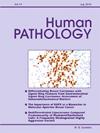Burkitt lymphoma
IF 2.7
2区 医学
Q2 PATHOLOGY
引用次数: 0
Abstract
Burkitt lymphoma is a mature aggressive B-cell neoplasm with distinctive clinical and morphologic features, a germinal center B-cell immunophenotype, a high proliferation index and MYC rearrangement with an immunoglobulin gene partner. Initially described in equatorial Africa by a surgeon, Denis Burkitt, African (endemic) Burkitt lymphoma was the first neoplasm shown to be associated with a virus, Epstein-Barr virus (EBV), and the first neoplasm shown to be associated with a chromosomal translocation, IGH::MYC. In this article, we provide a brief historical introduction of Burkitt lymphoma, followed by a review of all aspects of this neoplasm including pathogenesis, clinical presentation, morphology, immunophenotype, cytogenetics and molecular findings. We also provide recent updates of this entity, including advances in our understanding of molecular pathogenesis of Burkitt lymphoma and the recent proposal in the current World Health Organization classification that the traditional epidemiologic variants of Burkitt lymphoma are better replaced by presence or absence of EBV infection. We also discuss the differential diagnosis of Burkitt lymphoma and how this neoplasm can be distinguished from reactive conditions and other aggressive B-cell lymphomas/leukemias. Given its very rapid growth and the unique treatment approach employed to treat these patients, it is important to recognize Burkitt lymphoma to facilitate appropriate therapy.
伯基特淋巴瘤。
伯基特淋巴瘤是一种成熟的侵袭性b细胞肿瘤,具有独特的临床和形态学特征,具有生发中心b细胞免疫表型,高增殖指数和MYC重排与免疫球蛋白基因伴侣。非洲(地方性)伯基特淋巴瘤最初由外科医生丹尼斯·伯基特(Denis Burkitt)在赤道非洲描述,是第一个被证实与eb病毒(EBV)有关的肿瘤,也是第一个被证实与染色体易位(IGH::MYC)有关的肿瘤。在本文中,我们简要介绍了伯基特淋巴瘤的历史,然后回顾了该肿瘤的各个方面,包括发病机制,临床表现,形态学,免疫表型,细胞遗传学和分子研究结果。我们还提供了该实体的最新更新,包括我们对伯基特淋巴瘤分子发病机制的理解的进展,以及最近在当前世界卫生组织分类中提出的伯基特淋巴瘤的传统流行病学变异更好地由存在或不存在EBV感染取代的建议。我们还讨论了伯基特淋巴瘤的鉴别诊断,以及如何将这种肿瘤与反应性条件和其他侵袭性b细胞淋巴瘤/白血病区分开来。鉴于其快速发展和独特的治疗方法用于治疗这些患者,重要的是要认识到伯基特淋巴瘤,以促进适当的治疗。
本文章由计算机程序翻译,如有差异,请以英文原文为准。
求助全文
约1分钟内获得全文
求助全文
来源期刊

Human pathology
医学-病理学
CiteScore
5.30
自引率
6.10%
发文量
206
审稿时长
21 days
期刊介绍:
Human Pathology is designed to bring information of clinicopathologic significance to human disease to the laboratory and clinical physician. It presents information drawn from morphologic and clinical laboratory studies with direct relevance to the understanding of human diseases. Papers published concern morphologic and clinicopathologic observations, reviews of diseases, analyses of problems in pathology, significant collections of case material and advances in concepts or techniques of value in the analysis and diagnosis of disease. Theoretical and experimental pathology and molecular biology pertinent to human disease are included. This critical journal is well illustrated with exceptional reproductions of photomicrographs and microscopic anatomy.
 求助内容:
求助内容: 应助结果提醒方式:
应助结果提醒方式:


